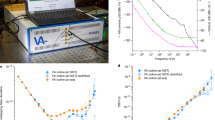Abstract
The Voyager 2 spacecraft will encounter Uranus in January 1986,and will provide the first spacecraft observations of that planet.It carries an infrared interferometer spectrometer (IRIS) whichhas already detected a variety of infrared active gases in theatmospheres of Jupiter, Saturn and Titan1–4. Some of the detected gases are not in chemical equilibrium but have sources in the deep atmosphere. IRIS observations of these non-equilibrium gases, in particular PH3 (mixing ratio ≃6×10−7) and GeH4 ( ≃ 7×10−10) on Jupiter1 and PH3 ( ≃ 1×10−6) on Saturn3, can be used to deduce the strength of convective mixing in the deepatmospheres of Jupiter and Saturn5,6. Similar deductions could be made about convective mixing rates in the deep atmosphere of Uranus if models of the equilibrium chemistry and thermochemicalkinetics were available to help interpret IRIS observations of the visible Uranus atmosphere. We describe here the results of comprehensive thermochemical equilibrium and chemical kinetic calculations for Uranus. We predict that the most abundant non-equilibrium trace gas derived from the deep atmosphere of Uranus is N2; other important non-equilibrium species include HCl, HF, GeH4, C2H6, PH3, H2Se, CH3SH, CO, CH3NH2, CH3OH, and CO2. Some of these species are detectable potentially by the Voyager instruments.
This is a preview of subscription content, access via your institution
Access options
Subscribe to this journal
Receive 51 print issues and online access
$199.00 per year
only $3.90 per issue
Buy this article
- Purchase on Springer Link
- Instant access to full article PDF
Prices may be subject to local taxes which are calculated during checkout
Similar content being viewed by others
References
Kunde, V. et al. Astrophys. J. 263, 443–467 (1982).
Gautier, D. et al. Astrophys. J. 257, 901–912 (1982).
Courtin, R., Gautier, D., Marten, A., Bexard, B. & Hanel, R. Astrophys. J. 287, 899–916 (1984).
Yung, Y. L., Allen, M. & Pinto, J. P. Astrophys. J. Suppl. 55, 465–506 (1984).
Prinn, R. G., Larson, H. P., Caldwell, J. J. & Gautier, D. in Saturn (eds Gehrels, T. & Matthews, M. S.) 88–149 (University of Arizona Press, 1984).
Fegley, B. Jr & Prinn, R. G. Astrophys. J. (in the press).
Hubbard, W. B. & MacFarlane, J. J. J. geophys. Res. 85, 225–234 (1980).
Fazio, G. G., Traub, W. A., Wright, E. L., Low, F. J. & Trafton, L. Astrophys. J. 209, 633–637 (1976).
Cameron, A. G. W. in Essays in Nuclear Astrophysics (eds Bames, C. A., Clayton, D. D. & Schramm, D. N.) 23–32 (Cambridge University Press, 1982).
Lewis, J. S. Icarus 16, 241–252 (1972).
Prinn, R. G. & Fegley, B. Jr, Astrophys. J. 249, 308–317 (1981).
Bergstralh, J. T. & Baines, K. H. in Uranus and Neptune (ed. Bergstralh, J. T.) 179–212 (NASA CP 2330, 1984).
Orton, G. S. & Appleby, J. F. in Uranus and Neptune (ed. Bergstralh, J. T.) 89–155 (NASA CP 2330, 1984).
Barshay, S. S. & Lewis, J. S. Icarus 33, 593–611 (1978).
Fegley, B. Jr & Lewis, J. S. Icarus 38, 166–179 (1979).
Prinn, R. G. & Barshay, S. S. Science 198, 1031–1034 (1977).
Prinn, R. G. & Olaguer, E. P. J. geophys. Res. 86, 9895–9899 (1981).
Lewis, J. S. & Prinn, R. G. Astrophys. J. 238, 357–364 (1980).
Prinn, R. G. & Lewis, J. S. Astrophys. J. 179, 333–341 (1973).
Gulkis, S., Janssen, M. A. & Olsen, E. T. Icarus 34, 10–19 (1978).
Atreya, S. K. & Romani, P. N. in Planetary Meteorology 17–68 (ed. Hunt, G. E.) (Cambridge University Press, 1985).
Stevenson, D. J. Bull. Am. astr. Soc. 16, 658 (1984).
Tsiklis, D. S., Linshits, L. R. & Goryunova, N. P. Russ. J. phys. Chem. 39, 1590–1592 (1965).
Keenan, J. H. & Keyes, F. G. Thermodynamic Properties of Steam (Wiley, New York, 1936).
Scatchard, G., Epstein, L. F., Warburton, J. Jr & Cody, P. G. Refrig. Engng 53, 413–421 (1947).
Hunten, D. M. in Uranus and Neptune (ed. Bergstralh, J. T.) 27–54 (NASA CP 2330,1984).
Stone, P. H. Space Sci. Rev. 14, 444–459 (1973).
Stone, P. H. in Jupiter (ed. Gehrels, T.) 586–617 (University of Arizona Press, 1976).
Flasar, M. & Gierasch, P. in Proc. Symp. Planetary Atmospheres (ed. Vallance-Jones, A.) 85–87 (Royal Society of Canada, Ottawa 1977).
Lewis, J. S. & Fegley, B. Jr Space Sci. Rev. 39, 163–192 (1984).
Mills, R. L., Liebenberg, D. H., Bronson, J. C. & Schmidth, L. C. J. chem. Phys. 66, 3076–3084 (1977).
Author information
Authors and Affiliations
Rights and permissions
About this article
Cite this article
Fegley, B., Prinn, R. Predicted chemistry of the deep atmosphere of Uranus before the Voyager 2 encounter. Nature 318, 48–50 (1985). https://doi.org/10.1038/318048a0
Received:
Accepted:
Published:
Issue Date:
DOI: https://doi.org/10.1038/318048a0
Comments
By submitting a comment you agree to abide by our Terms and Community Guidelines. If you find something abusive or that does not comply with our terms or guidelines please flag it as inappropriate.



